View in other NatureServe Network Field Guides
NatureServe
Montana
Utah
Wyoming
Idaho
Wisconsin
British Columbia
South Carolina
Yukon
California
New York
Shovelnose Sturgeon - Scaphirhynchus platorynchus
Native Species
Global Rank:
G4
State Rank:
S4
(see State Rank Reason below)
Agency Status
USFWS:
USFS:
BLM:
External Links
State Rank Reason (see State Rank above)
Species is widely distributed in eastern Montana river systems, generally stable and faces no significant threats
General Description
The smallest and most common sturgeon in Montana is the shovelnose sturgeon. It reaches a maximum weight of about 15 pounds. These fish can readily be taken on bait fished on the bottom and are pursued by relatively few anglers in the Missouri River downstream from Great Falls.
Diagnostic Characteristics
Dorsal fin has 30 to 36 rays; anal fin has 18 to 23 rays.
Species Range
Montana Range
Range Descriptions
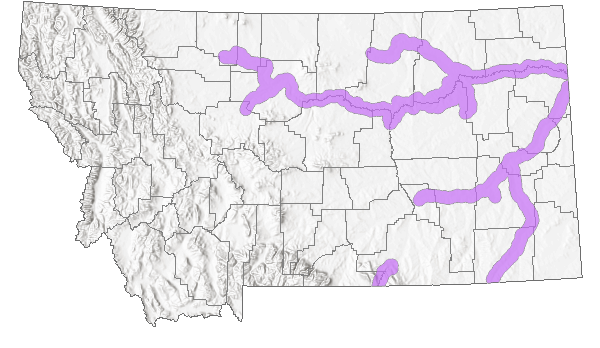
 Native
Native
Western Hemisphere Range
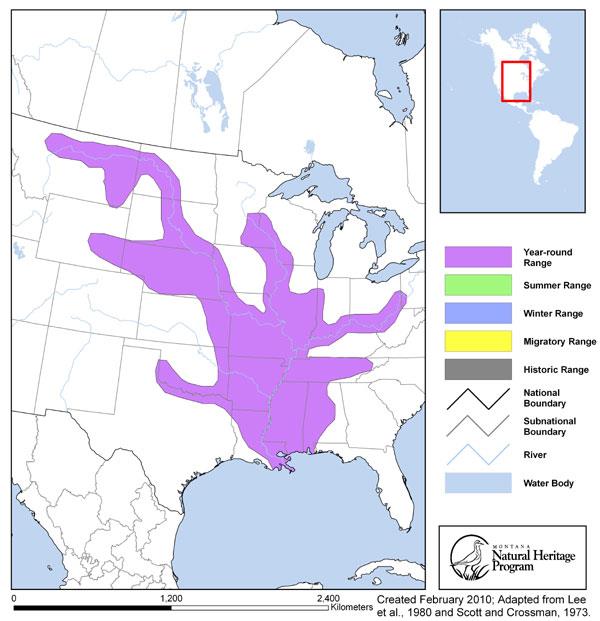
Observations in Montana Natural Heritage Program Database
Number of Observations: 552
(Click on the following maps and charts to see full sized version)
Map Help and Descriptions
Relative Density
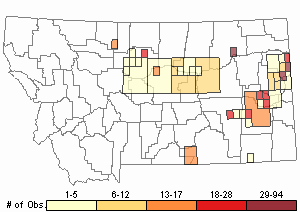
Recency
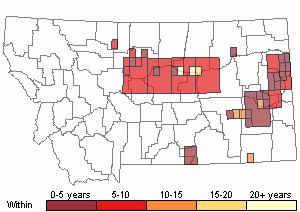
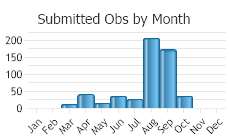
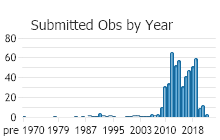
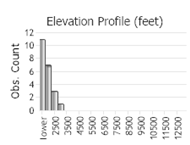 (Observations spanning multiple months or years are excluded from time charts)
(Observations spanning multiple months or years are excluded from time charts)
Migration
Long seasonal spawning movement from lower Missouri River upstream to mouth of Marias River. Dispersal downstream follows spawning (Berg 1981). This differs from the Yellowstone River where fish were somewhat concentrated in two areas in spring but dispersed the rest of the year throughout the Yellowstone and lower Missouri Rivers (Bramblett 1996).
Habitat
Large rivers over sand or gravel, often in strong current; also impoundments of these rivers. Tolerates turbid water. (FWP) In Montana, shovelnose sturgeon appear to utilize primarily large rivers (Bramblett 1996), but also use reservoirs to some extent. They are found in all channel types, primarily in straight reaches with islands (Bramblett 1996). They are found at depths ranging from 0.9 to 10.1 m and averaged 2.29 m (Bramblett 1996). Channel widths used are from 25 to 800 m, and averaged 208 m (Bramblett 1996). Bottom velocities range from 0.00-1.51 m/s, and average 0.78 m/s in riverine habitat (Bramblett 1996). They tolerate high turbidity. Spawning substrate is silt-free gravel bars; preferred substrate use year-long is primarily gravel and cobble (69%), while fines and sand (27%) are avoided (Bramblett 1996). However, small sturgeon (<5kg) may use areas over larger substrates (Erickson 1992).
Food Habits
Studies on middle Missouri River showed two species of mayflies comprising 58% of summer diet (Berg 1981). May occasionally feed on planktonic organisms (Brown 1971).
Ecology
Annual home ranges for shovelnose sturgeon in Montana ranged from 0.0 to 254.1 km with a median of 35 km; seasonal home ranges were smallest in winter and largest in summer (Bramblett 1996). Sturgeon were found to have moved 78% of the time between relocations; they moved up to 15.0 km/day and 6.6 km/hr (Bramblett 1996). The minimum flow required to trigger spawning migrations into the Tongue R. is between 500 - 600 cfs while optimum spawning flow is 1000 + cfs.
Reproductive Characteristics
Lower Marias, Tongue, and Powder River are important spawning areas in Montana. Spawns from May - early July at 60 - 70 degrees F. Eggs hatch in 1 week. Spawning peaks early June in middle Missouri River (Brown 1971, Berg 1981, Penkal 1981).
Stewardship Responsibility
References
- Literature Cited AboveLegend:
 View Online Publication
View Online Publication Berg, R.K. 1981. Fish populations of the wild and scenic Missouri River, Montana. Montana Department of Fish, Wildlife and Parks. 242 p.
Berg, R.K. 1981. Fish populations of the wild and scenic Missouri River, Montana. Montana Department of Fish, Wildlife and Parks. 242 p. Bramblett, R.G. 1996. Habitats and movements of pallid and shovelnose sturgeon in the Yellowstone and Missouri Rivers, Montana and North Dakota. Ph.D. Dissertation. Bozeman, MT: Montana State University. 210 p.
Bramblett, R.G. 1996. Habitats and movements of pallid and shovelnose sturgeon in the Yellowstone and Missouri Rivers, Montana and North Dakota. Ph.D. Dissertation. Bozeman, MT: Montana State University. 210 p. Brown, C.J.D. 1971. Fishes of Montana. Bozeman, MT: Big Sky Books/Montana State University. 207 p.
Brown, C.J.D. 1971. Fishes of Montana. Bozeman, MT: Big Sky Books/Montana State University. 207 p. Erickson, J.D. 1992. Habitat selection and movement of pallid Sturgeon in Lake Sharpe, South Dakota. Unpubl. M.S. Thesis. South Dakota State University, Brookings.
Erickson, J.D. 1992. Habitat selection and movement of pallid Sturgeon in Lake Sharpe, South Dakota. Unpubl. M.S. Thesis. South Dakota State University, Brookings. Lee, D.S., C.R. Gilbert, C.H. Hocutt, R.E. Jenkins, D. E. McAllister, J. R. Stauffer, Jr. 1980. Atlas of North American freshwater fishes. North Carolina State Musuem of Natural History. 867 p.
Lee, D.S., C.R. Gilbert, C.H. Hocutt, R.E. Jenkins, D. E. McAllister, J. R. Stauffer, Jr. 1980. Atlas of North American freshwater fishes. North Carolina State Musuem of Natural History. 867 p. Penkal, R.F. 1981. Life history and flow requirements of paddlefish, shovelnose sturgeon, channel catfish, and other fish in the lower Yellowstone River system. Montana Department of Fish, Wildlife, and Parks. 53 p.
Penkal, R.F. 1981. Life history and flow requirements of paddlefish, shovelnose sturgeon, channel catfish, and other fish in the lower Yellowstone River system. Montana Department of Fish, Wildlife, and Parks. 53 p. Scott, W.B. and E.J. Crossman. 1973. Rainbow trout, Kamloops trout, Steelhead trout Salmo gairdneri Richardson. pp. 184-191. In: Freshwater fishes of Canada. Ottawa, Canada: Fisheries Research Board of Canada, Bulletin 184. 966 p.
Scott, W.B. and E.J. Crossman. 1973. Rainbow trout, Kamloops trout, Steelhead trout Salmo gairdneri Richardson. pp. 184-191. In: Freshwater fishes of Canada. Ottawa, Canada: Fisheries Research Board of Canada, Bulletin 184. 966 p.
- Additional ReferencesLegend:
 View Online Publication
View Online Publication
Do you know of a citation we're missing? Craig, V.E. 1952. A story of fish production as it applies to Montana. M.Sc. Thesis. Bozeman, MT: Montana State University. 92 p.
Craig, V.E. 1952. A story of fish production as it applies to Montana. M.Sc. Thesis. Bozeman, MT: Montana State University. 92 p. Dieterman, D.J., M.P. Ruggles, M.L. Wildhaber, and D.L. Galat (eds). 1996. Population structure and habitat use of benthic fishes along the Missouri and Lower Yellowstone Rivers. 1996 Annual report of Missouri River Benthic Fish Study PD-95-5832 to U.S. Army Corps of Engineers and U.S. Bureau of Reclamation. 238 p.
Dieterman, D.J., M.P. Ruggles, M.L. Wildhaber, and D.L. Galat (eds). 1996. Population structure and habitat use of benthic fishes along the Missouri and Lower Yellowstone Rivers. 1996 Annual report of Missouri River Benthic Fish Study PD-95-5832 to U.S. Army Corps of Engineers and U.S. Bureau of Reclamation. 238 p. Duncan, M.B. 2019. Distributions, abundances, and movements of small, nongame fishes in a large Great Plains river network. Ph.D. Dissertation. Bozeman, MT: Montana State University. 255 p.
Duncan, M.B. 2019. Distributions, abundances, and movements of small, nongame fishes in a large Great Plains river network. Ph.D. Dissertation. Bozeman, MT: Montana State University. 255 p. Gerrity, P.C. 2005. Habitat use, diet, and growth of hatchery-reared juvenile pallid sturgeon and indigenous shovelnose sturgeon in the Missouri River above Fort Peck Reservoir. M.Sc. Thesis. Bozeman, MT: Montana State University. 62 p.
Gerrity, P.C. 2005. Habitat use, diet, and growth of hatchery-reared juvenile pallid sturgeon and indigenous shovelnose sturgeon in the Missouri River above Fort Peck Reservoir. M.Sc. Thesis. Bozeman, MT: Montana State University. 62 p. Goodman, B.J. 2009. Ichthyoplankton density and Shovelnose Sturgeon spawning in relation to varying discharge treatments. M.Sc. Thesis. 82 p.
Goodman, B.J. 2009. Ichthyoplankton density and Shovelnose Sturgeon spawning in relation to varying discharge treatments. M.Sc. Thesis. 82 p. Holton, G.D. 1981. Identification of Montana's most common game and sport fishes. Montana Outdoors May/June reprint. 8 p.
Holton, G.D. 1981. Identification of Montana's most common game and sport fishes. Montana Outdoors May/June reprint. 8 p. Joslin, Gayle, and Heidi B. Youmans. 1999. Effects of recreation on Rocky Mountain wildlife: a review for Montana. [Montana]: Montana Chapter of the Wildlife Society.
Joslin, Gayle, and Heidi B. Youmans. 1999. Effects of recreation on Rocky Mountain wildlife: a review for Montana. [Montana]: Montana Chapter of the Wildlife Society. Megargle, D.J. 1997. Temporal variation in food selection of shovelnose sturgeon in the Missouri River above Fort Peck Reservoir, MT. M.Sc. Thesis. Bozeman, MT: Montana State University. 127 p.
Megargle, D.J. 1997. Temporal variation in food selection of shovelnose sturgeon in the Missouri River above Fort Peck Reservoir, MT. M.Sc. Thesis. Bozeman, MT: Montana State University. 127 p. Montana Department of Fish, Wildlife and Parks. 1989. Northeast Montana Warmwater Ecosystem Investigations: project period 7/1/88 through 6/30/89. Proj.# F-46-R-2; Job# V-e. 21p.
Montana Department of Fish, Wildlife and Parks. 1989. Northeast Montana Warmwater Ecosystem Investigations: project period 7/1/88 through 6/30/89. Proj.# F-46-R-2; Job# V-e. 21p. Mullins, M.S. 1991. Biology and predator use of cisco (Coregonus artedi) in Fort Peck Reservoir, Montana. M.Sc. Thesis. Bozeman, MT: Montana State University. 68 p.
Mullins, M.S. 1991. Biology and predator use of cisco (Coregonus artedi) in Fort Peck Reservoir, Montana. M.Sc. Thesis. Bozeman, MT: Montana State University. 68 p. Stash, S.W. 2001. Distribution, relative abundance, and habitat associations of Milk River fishes related to irrigation diversion dams. M.Sc. Thesis. Bozeman, MT: Montana State University. 82 p.
Stash, S.W. 2001. Distribution, relative abundance, and habitat associations of Milk River fishes related to irrigation diversion dams. M.Sc. Thesis. Bozeman, MT: Montana State University. 82 p. Tews, A.E. 1994. Pallid sturgeon and shovelnose sturgeon in the Missouri River from Fort Peck Dam to Lake Sakakawea and in the Yellowstone from Intake to its mouth. Fort Peck pallid sturgeon study. MTFWP Final Report to U.S. Army Corps Engineers. 87 p.
Tews, A.E. 1994. Pallid sturgeon and shovelnose sturgeon in the Missouri River from Fort Peck Dam to Lake Sakakawea and in the Yellowstone from Intake to its mouth. Fort Peck pallid sturgeon study. MTFWP Final Report to U.S. Army Corps Engineers. 87 p. Trenka, R.J. 2000. Community structure and habitat associations of fishes of the lower Tongue and Powder Rivers. M.Sc. Thesis. Bozeman, MT: Montana State University. 85 p.
Trenka, R.J. 2000. Community structure and habitat associations of fishes of the lower Tongue and Powder Rivers. M.Sc. Thesis. Bozeman, MT: Montana State University. 85 p. USDI Bureau of Land Management. No date. Fishes of the Miles city, Montana BLM District. Miles City, MT: Miles City BLM District pamphlet. 12 p.
USDI Bureau of Land Management. No date. Fishes of the Miles city, Montana BLM District. Miles City, MT: Miles City BLM District pamphlet. 12 p. Young, B.A., T.L. Welker, M.L. Wildhaber, C.R. Berry, and D. Scarnecchia (eds). 1997. Population structure and habitat use of benthic fishes along the Missouri and Lower Yellowstone Rivers. 1997 Annual report of Missouri River Benthic Fish Study PD-95-5832 to U.S. Army Corps of Engineers and U.S. Bureau of Reclamation. 207 p.
Young, B.A., T.L. Welker, M.L. Wildhaber, C.R. Berry, and D. Scarnecchia (eds). 1997. Population structure and habitat use of benthic fishes along the Missouri and Lower Yellowstone Rivers. 1997 Annual report of Missouri River Benthic Fish Study PD-95-5832 to U.S. Army Corps of Engineers and U.S. Bureau of Reclamation. 207 p.
- Web Search Engines for Articles on "Shovelnose Sturgeon"
- Additional Sources of Information Related to "Fish"





